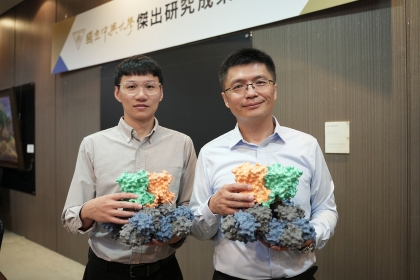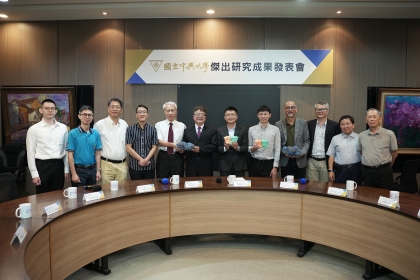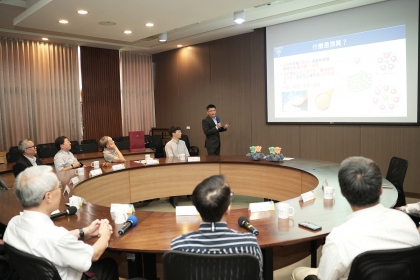Breakthrough Research Collaboration Leads to Potential New Antibiotics and Neurological Disease Treatments
2024-06-14
興新聞張貼者
Unit秘書室
1,625
In a significant advancement for microbiology and potential human health, Associate Professor Nien-Jen Hu and his team at the Institute of Biochemistry, National Chung Hsing University, have cracked the molecular structure of bacterial potassium ion channel protein KtrAB. This breakthrough sheds light on how bacteria regulate their internal potassium ion levels to adapt to varying osmotic pressures in the environment.
Published in the esteemed journal Nature Communications in May 2024, the study unveils the high-resolution structures of KtrAB in both open and closed states, achieved through cutting-edge cryo-electron microscopy (Cryo-EM) technology. Collaborating with Academician Tsai Ming-Daw from Academia Sinica, the researchers delved into the intricate mechanisms by which KtrAB responds to adenosine triphosphate (ATP) to open and adenosine diphosphate (ADP) to close.
Of paramount importance is the revelation of sodium ions' role in activating the KtrAB channel. By identifying the precise binding site of sodium ions in the ATP-KtrAB protein complex, the team confirmed that sodium ions, in conjunction with ATP, facilitate the opening of the channel. This discovery holds significant physiological implications, as it addresses the toxic effects of excessive sodium ion concentrations within bacterial cells, necessitating the influx of potassium ions for cellular balance and survival.
Associate Professor Hu emphasized the collaborative nature of the research, which was made possible by long-term funding from the National Science Council (NSC) and involved multiple research teams from prominent institutions such as Academia Sinica, National Taiwan University, and the University of Leeds in the United Kingdom. Technical support from the Protein Mass Spectrometry Core Laboratory at the Biotechnology Center of National Chung Hsing University played a pivotal role in the project's completion.
Beyond its implications for bacterial survival mechanisms, the study lays the groundwork for the development of novel antibiotics targeting KtrAB. Additionally, insights into the activation of potassium ion channels by sodium ions offer promising avenues for addressing neurological disorders, caused by the mutation of Na+-activated K+ channel (KNa), including epilepsy and seizure.
This groundbreaking research not only underscores the expertise of National Chung Hsing University in membrane protein structure research but also paves the way for innovative treatments for bacterial infections and neurological diseases in the future.
Published in the esteemed journal Nature Communications in May 2024, the study unveils the high-resolution structures of KtrAB in both open and closed states, achieved through cutting-edge cryo-electron microscopy (Cryo-EM) technology. Collaborating with Academician Tsai Ming-Daw from Academia Sinica, the researchers delved into the intricate mechanisms by which KtrAB responds to adenosine triphosphate (ATP) to open and adenosine diphosphate (ADP) to close.
Of paramount importance is the revelation of sodium ions' role in activating the KtrAB channel. By identifying the precise binding site of sodium ions in the ATP-KtrAB protein complex, the team confirmed that sodium ions, in conjunction with ATP, facilitate the opening of the channel. This discovery holds significant physiological implications, as it addresses the toxic effects of excessive sodium ion concentrations within bacterial cells, necessitating the influx of potassium ions for cellular balance and survival.
Associate Professor Hu emphasized the collaborative nature of the research, which was made possible by long-term funding from the National Science Council (NSC) and involved multiple research teams from prominent institutions such as Academia Sinica, National Taiwan University, and the University of Leeds in the United Kingdom. Technical support from the Protein Mass Spectrometry Core Laboratory at the Biotechnology Center of National Chung Hsing University played a pivotal role in the project's completion.
Beyond its implications for bacterial survival mechanisms, the study lays the groundwork for the development of novel antibiotics targeting KtrAB. Additionally, insights into the activation of potassium ion channels by sodium ions offer promising avenues for addressing neurological disorders, caused by the mutation of Na+-activated K+ channel (KNa), including epilepsy and seizure.
This groundbreaking research not only underscores the expertise of National Chung Hsing University in membrane protein structure research but also paves the way for innovative treatments for bacterial infections and neurological diseases in the future.




